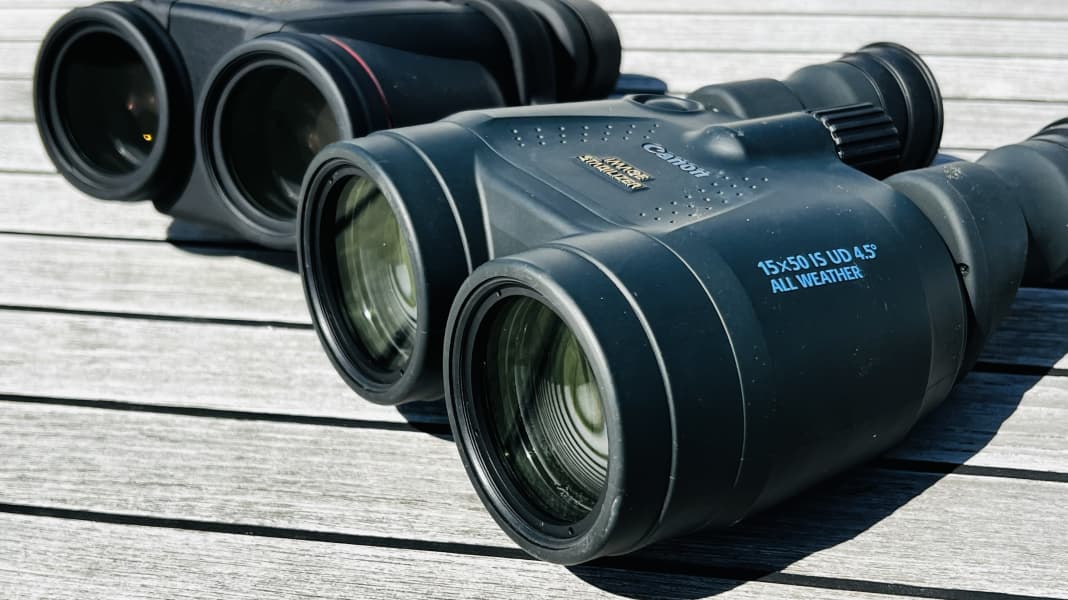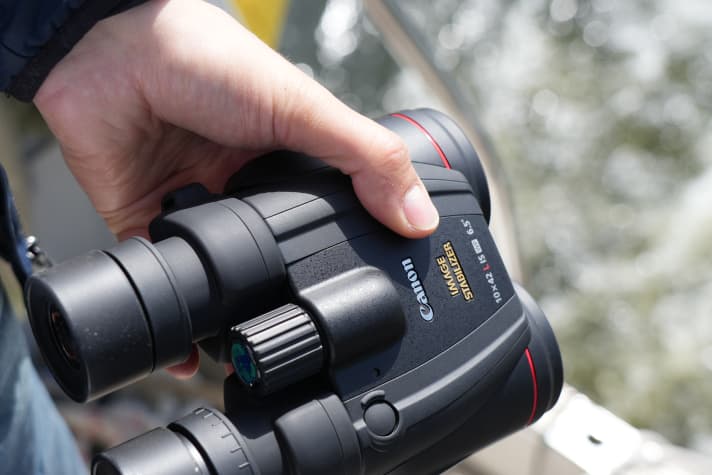
Binoculars for on-board use have a magnification of seven times and the diameter of the entrance pupil is 50 millimetres. In short: 7x50. That's it, that's it. The reasons for this are to be found in on-board practice: in rough seas, a sevenfold magnification can just about be held steady by hand without the image blurring too much. And the diameter of 50 millimetres guarantees a clear and bright image with a handy size and acceptable weight.
Binoculars with microprocessor
Since the advent of microelectronics in binoculars, however, the limits of what is technically feasible have shifted. Modern binoculars, such as the Canon 10x42L IS and the larger 15x50 IS All Weather that we tested, work with a so-called image stabiliser, which also allows higher magnification values. Technically speaking, an acceleration sensor recognises movement. The detected movement information is then passed on to a microprocessor, which processes the information and makes the necessary adjustments to stabilise the image. The image stabiliser in the Canon lenses works with the so-called Vari-Angle Prism system. This uses sensors that recognise the smallest movements such as hand tremors. These movements are then passed on to microprocessors which immediately adjust the position of moving prisms within the binoculars.

Technology prevents tremors
The shifting of the prisms corrects the light paths and thus stabilises the image. The result is a more stable, less blurred image in the binoculars. In our practical test on the Elbe, both models were able to perfectly compensate for moderate boat movements and, above all, the disturbing "shaking". In practice, it was possible to clearly identify the next buoy, the light signals at locks or harbour entrances not only at a distance of 200 metres, but already at a distance of 300 or 400 metres. However, anyone who believes that any boat movement can be eliminated by processor assistance is mistaken. It should be emphasised that the 15x50 binoculars in particular offer a magnification that would be impractical without electronic stabilisation.
With weights of 1.1 kilograms (10x42) and 1.2 kilograms (15x50), both binoculars are not among the lightest in their class. The field of view at a distance of 1,000 metres is naturally greater with the 10x42 at around 114 metres than with the 15x50 at 79 metres. Both binoculars are focused via a centre drive that can be operated precisely. While the 10x42 binoculars are classed as "waterproof" by Canon, the 15x50 are only protected against rain and splash water.
Binoculars in two versions
We did not like the unsecured lens caps and eyepiece caps that were too loose. The unusual design due to the complex technology fits well in the hand, but should be held with both hands. The prices of the Canon lenses are between 1,100 and 1,300 euros, depending on the source of supply.
Conclusion: With the Image Stabiliser models 10x42L IS and 15x50 IS, Canon brings two high-tech binoculars to the boat that are second to none and represent a great improvement in use on board. Like any electronic device, they will of course only work for as long as the batteries last. The manufacturer claims up to eight hours of use. Spare batteries for the binoculars should therefore always be on board.
Binoculars: alternatives on the market
Steiner LRF 1700 8x30
The Steiner LRF 1700 8x30 offers an optical rangefinder with laser. The distance to the target in the image is determined by measuring the time of flight of the light pulse and displayed in the right-hand beam path as a reddish illuminated number. The measuring range extends to approximately one nautical mile (1,700 metres). The porro prism system means that focussing is not necessary. The image itself is sharp, clear and offers true-to-life colours. However, the 30 millimetre objective lens width means that use in twilight is somewhat limited. The field of view measures 114 metres at a distance of 1,000 metres. The lens measures 145 x 163 x 74 millimetres and weighs 810 grams. Price: 1,700 euros.
Minox BN 7x50 C
The Minox BN 7x50 C binoculars are the test winner from YACHT 10/2018. They are robust, equipped with rubberised grip surfaces, waterproof, floatable and deliver a clear and high-contrast image even into the twilight. Thanks to the porro prism system, there are no moving parts in the beam path, which increases robustness. For spectacle wearers, the dioptres can be adjusted on both sides for a clear image. The lens has an integrated analogue compass, which can also be illuminated. This makes it possible to take bearings. The dimensions are 152 x 200 x 81 millimetres. At a distance of 1,000 metres, it offers a field of view of 121 metres, a good value. Price: 360 euros.

